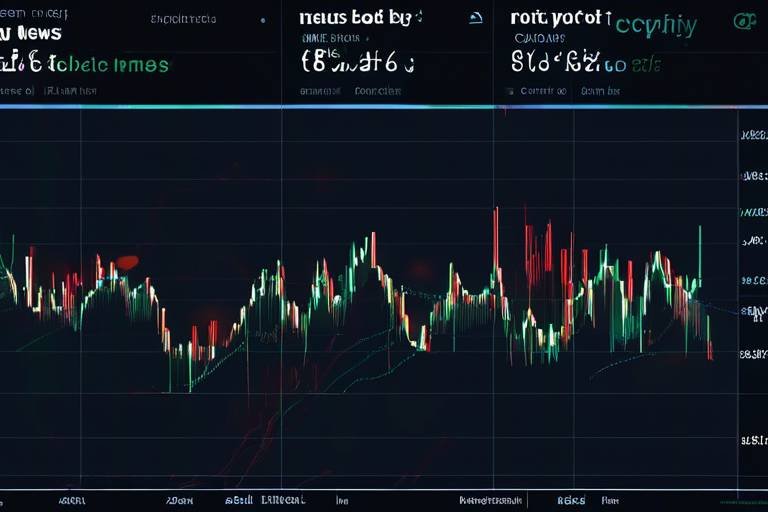How to Leverage Market Reports for Investment Insights
In today's fast-paced financial landscape, making informed investment decisions can feel like trying to find a needle in a haystack. The good news? Market reports are your flashlight in that haystack, illuminating the path to smarter choices. These reports are treasure troves of data, providing insights that can significantly enhance your decision-making process. But how do you leverage these resources effectively? Let’s dive into the world of market reports and uncover how they can give you a competitive edge in your investment strategies.
First off, understanding what market reports are is crucial. Think of them as detailed maps of the investment terrain. They offer valuable data and analysis on economic trends, sector performance, and consumer behavior. Each report serves as a guide, helping investors navigate through the complexities of the market. By effectively utilizing these reports, you can not only make informed decisions but also anticipate market shifts before they happen, positioning yourself ahead of the curve.
Now, let’s talk about the different types of market reports you might encounter. Each type serves a unique purpose and can significantly impact your investment strategies. For instance, industry analysis reports focus on specific sectors, providing insights into market size, growth potential, and key players. This information helps investors identify lucrative opportunities that may otherwise go unnoticed. On the other hand, competitor benchmarking reports allow you to compare a company’s performance against its peers. This comparison can highlight strengths and weaknesses, informing your investment decisions in a way that maximizes your returns.
So, what exactly can you expect to find in an industry analysis report? These reports delve deep into key metrics that are essential for evaluating industry performance. Metrics like market share, revenue growth, and profit margins are the lifeblood of these reports. Understanding these figures is crucial for assessing the viability of potential investments. For example, if a particular industry shows consistent revenue growth alongside increasing market share, it might be worth considering for your portfolio.
To further illustrate, let’s take a look at some key metrics that are often highlighted in industry reports:
| Metric | Description |
|---|---|
| Market Share | The percentage of an industry or market that a particular company controls. |
| Revenue Growth | The increase in a company’s sales over a specific period. |
| Profit Margins | The difference between the revenue generated and the costs incurred. |
Investors can access these industry reports from various sources, including market research firms, financial institutions, and government publications. This diversity of sources ensures that you have a comprehensive view of the market landscape, allowing you to make well-rounded decisions. The more data you have at your fingertips, the better equipped you are to tackle the challenges of the investment world.
But it doesn’t stop there. Another essential aspect of market reports is the consumer insights they provide. Understanding consumer preferences and behaviors can be a game-changer for investors. By gauging market demand through consumer data, you can make strategic investment choices that align with current trends. This proactive approach can be likened to surfing; you want to catch the right wave at the right time to ride it to success.
Analyzing consumer data allows you to understand market dynamics and anticipate shifts in demand. This can influence not only your investment timing but also your overall strategy. For instance, if reports indicate a rising trend in eco-friendly products, investing in companies that align with this trend could yield significant returns. Remember, the market is constantly evolving, and staying ahead means keeping your finger on the pulse of consumer behavior.
Finally, it’s not enough just to gather insights from market reports; you need to integrate these findings into your overall investment strategy. This integration enhances your portfolio performance and helps mitigate risks. Think of it as assembling a puzzle; each piece of data from your reports helps complete the picture of your investment landscape. By aligning your strategies with the insights gleaned from market reports, you can navigate the complexities of investing with confidence.
- What are market reports? Market reports are detailed documents that provide data and analysis on economic trends, sector performance, and consumer behavior.
- How can I access market reports? You can access market reports through market research firms, financial institutions, and government publications.
- Why are consumer insights important? Consumer insights help investors understand market demand and anticipate shifts, allowing for better investment decisions.
- How can I integrate market insights into my investment strategy? By analyzing data from market reports and aligning your investment choices accordingly, you can enhance your portfolio performance and reduce risks.

Understanding Market Reports
Market reports are the unsung heroes of the investment world, providing a treasure trove of data and insights that can make or break an investment decision. Imagine you’re navigating a vast ocean of investment opportunities; these reports are your compass, guiding you through the choppy waters of economic trends, sector performance, and consumer behavior. They distill complex information into actionable insights, helping investors make informed choices that can lead to lucrative returns.
At their core, market reports are designed to illuminate the current state of various markets. They offer a snapshot of economic conditions, highlighting crucial metrics that can inform your investment strategy. For example, a well-structured market report will typically cover aspects such as:
- Economic Trends: Understanding macroeconomic indicators like GDP growth, inflation rates, and employment statistics.
- Sector Performance: Analyzing how different sectors are performing relative to each other.
- Consumer Behavior: Gaining insights into what consumers are buying and why.
By synthesizing this information, market reports empower investors to make decisions based on data rather than intuition alone. This is particularly important in today’s fast-paced market environment, where trends can shift overnight. Think of market reports as your investment GPS, helping you avoid pitfalls and guiding you towards the most promising opportunities.
Furthermore, understanding how to interpret these reports is just as critical as having access to them. Investors need to be able to discern the significance of the data presented. For instance, a report might show that a particular industry is experiencing a downturn. However, by digging deeper, you might discover that this is only true for a segment of that industry, while another segment is thriving. This level of analysis can reveal hidden opportunities that others might overlook.
In summary, market reports are indispensable tools for investors. They not only provide a wealth of information but also help investors develop a nuanced understanding of market dynamics. By leveraging these reports effectively, investors can enhance their decision-making processes, identify trends, and ultimately gain a competitive edge in their investment strategies.

Types of Market Reports
When it comes to investing, understanding the various types of market reports can be a game-changer. These reports are not just dry documents filled with numbers; they are the lifeblood of informed decision-making. Each type of report serves a unique purpose, providing insights that can significantly impact your investment strategies. Let’s dive into the different types of market reports that investors should be aware of.
First up, we have Industry Analysis Reports. These reports focus on specific industries and provide an in-depth look at market size, growth potential, and key players. Imagine you're a treasure hunter, and these reports are your map. They help you identify lucrative opportunities by highlighting which sectors are booming and which are on the decline. For instance, if a report indicates a surge in renewable energy investments, it might be time to consider adding some green stocks to your portfolio.
To truly leverage industry analysis reports, it's essential to understand key metrics such as market share, revenue growth, and profit margins. These metrics are like the compass that guides you through the investment landscape. By evaluating these indicators, you can assess the performance of an industry and determine its potential for growth. For instance, a company with a rapidly increasing market share may indicate a strong competitive position, making it an attractive investment opportunity.
Now, where can you find these valuable industry reports? Investors can access them from a variety of sources, including market research firms, financial institutions, and government publications. Each source offers a different perspective, ensuring you have a comprehensive view of the market landscape. For example, government publications might provide macroeconomic data, while market research firms often delve into consumer behavior trends. By gathering insights from multiple sources, you can paint a clearer picture of potential investment opportunities.
Next, we have Competitor Benchmarking Reports. These reports are invaluable for comparing a company’s performance against its peers. Think of them as a report card for businesses. They highlight strengths and weaknesses, allowing investors to make informed decisions based on a company's competitive standing. If a company is outperforming its competitors in terms of revenue growth or customer satisfaction, it might be a strong candidate for investment.
In addition to these, Consumer Insights Reports are crucial for understanding market demand. These reports reveal consumer preferences and behaviors, giving investors a glimpse into what drives purchasing decisions. By analyzing this data, investors can gauge market dynamics and anticipate shifts in demand. For instance, if a report shows a growing trend in plant-based food consumption, it might be wise to consider investing in companies within that sector.
Finally, integrating insights from various market reports into your overall investment strategy is key. By combining data from industry analysis, competitor benchmarking, and consumer insights, you can enhance your portfolio's performance and mitigate risks. It’s like assembling a puzzle; each piece adds depth and clarity to your investment picture, helping you make well-informed decisions.
| Type of Report | Description | Key Benefits |
|---|---|---|
| Industry Analysis | Focuses on specific industries, offering insights into market size and growth potential. | Identifies lucrative investment opportunities. |
| Competitor Benchmarking | Compares a company’s performance against its peers. | Highlights strengths and weaknesses for informed decision-making. |
| Consumer Insights | Reveals consumer preferences and behaviors. | Helps gauge market demand and anticipate shifts. |

Industry Analysis Reports
When diving into the world of investments, are like treasure maps, guiding investors toward potential gold mines. These reports are meticulously crafted to focus on specific industries, providing a wealth of insights into market size, growth potential, and key players. Imagine trying to navigate a vast ocean without a compass; that's what investing without these reports feels like. They help investors identify lucrative opportunities that might otherwise go unnoticed.
One of the most compelling aspects of these reports is their ability to highlight the growth potential of an industry. For instance, if a report reveals that the renewable energy sector is expected to grow exponentially in the next five years, savvy investors will want to jump on that bandwagon early. Conversely, if an industry is forecasted to decline, it’s a red flag that could save investors from sinking their hard-earned money into a failing venture.
Moreover, these reports often delve into the competitive landscape, showcasing the key players within the industry. By understanding who the major competitors are and their market shares, investors can make more informed decisions about where to allocate their resources. For example, if a report indicates that a particular company is gaining market share rapidly, it might be worth considering an investment in that company or its suppliers.
When analyzing Industry Analysis Reports, it’s crucial to pay attention to certain key metrics. These metrics act as the heartbeat of the industry, providing insights into its health and viability. Here are a few essential metrics to consider:
- Market Share: This indicates how much of the market is controlled by a company or product, giving insights into its competitive strength.
- Revenue Growth: A clear indicator of how well a company is performing over time, signaling whether it’s a good investment opportunity.
- Profit Margins: Understanding the profit margins of key players can help investors gauge the financial health and sustainability of companies within the industry.
By focusing on these metrics, investors can evaluate industry performance and potential investment viability with a sharper lens. It’s like having a magnifying glass that reveals the intricate details of a complex puzzle, allowing for a clearer picture of the investment landscape.
Investors can access Industry Analysis Reports from a variety of sources, ensuring a comprehensive view of the market landscape. Some of the most reliable sources include:
- Market Research Firms: These organizations specialize in gathering and analyzing data, providing detailed reports tailored to specific industries.
- Financial Institutions: Many banks and investment firms publish their own reports, often leveraging their vast resources and expertise.
- Government Publications: Government agencies frequently release economic data and industry reports that can be invaluable to investors.
In conclusion, Industry Analysis Reports are indispensable tools for investors looking to enhance their decision-making processes. By providing a detailed look into industry dynamics, these reports empower investors to make informed choices that can lead to greater returns and reduced risks. So, the next time you consider an investment, remember to consult these reports—they might just hold the key to unlocking your financial success!

Key Metrics in Industry Reports
When diving into industry reports, understanding the key metrics is like having a treasure map in the world of investments. These metrics act as your compass, guiding you through the intricate landscape of market performance and potential opportunities. Some of the most critical metrics include market share, revenue growth, and profit margins. Each of these plays a pivotal role in evaluating whether a particular industry is worth your investment.
Market share indicates the percentage of an industry that a company controls compared to its competitors. It’s not just about being a big fish in a small pond; it’s about understanding how that fish is swimming in a larger ocean. A company with a significant market share often has more resources and brand recognition, which can translate to stability and sustainability.
Next up is revenue growth. This metric reveals how much a company’s sales are increasing over a specific period. Think of it as the heartbeat of the business; if the heart is strong and pumping effectively, the company is likely thriving. Consistent revenue growth suggests that the company is not only attracting customers but also retaining them, which is essential for long-term success.
Then, we have profit margins. This metric tells you how much profit a company makes for every dollar of sales. A healthy profit margin indicates that a company is managing its costs effectively. If you imagine a company as a restaurant, the profit margin would be the difference between the cost of ingredients and the price of the meal. The higher the margin, the more room there is for the business to grow and weather economic storms.
To further illustrate these metrics, let’s take a look at the following table:
| Metric | Definition | Importance |
|---|---|---|
| Market Share | Percentage of total sales in the market controlled by a company. | Indicates competitive position and market dominance. |
| Revenue Growth | Rate at which a company's sales increase over time. | Reflects business health and customer retention. |
| Profit Margins | Percentage of revenue that exceeds the costs of goods sold. | Shows financial efficiency and profitability potential. |
By grasping these metrics, investors can assess the viability of potential investments with a sharper eye. They can identify industries that not only promise growth but also possess the resilience to thrive in fluctuating market conditions. So, the next time you sift through an industry report, remember these metrics. They are your allies in the quest for successful investments!
What are industry reports?
Industry reports are comprehensive documents that analyze market trends, competitive landscapes, and economic conditions within specific sectors. They provide valuable insights that can help investors make informed decisions.
How do I access industry reports?
You can access industry reports through market research firms, financial institutions, and government publications. Many organizations also offer free summaries or excerpts that can give you a taste of the full report.
Why are key metrics important?
Key metrics such as market share, revenue growth, and profit margins help investors evaluate the performance and potential of companies within an industry. They provide a clearer picture of where to invest and what to avoid.
Can I rely solely on industry reports for investment decisions?
While industry reports are invaluable resources, it's essential to complement them with other research and insights. Market conditions can change rapidly, so a well-rounded approach is crucial for successful investing.

Sources of Industry Reports
When it comes to making informed investment decisions, the play a pivotal role. Investors need reliable data to navigate the complexities of the market, and understanding where to find this information can significantly enhance their decision-making process. There are several key sources to consider, each providing unique insights that can help paint a comprehensive picture of the market landscape.
Firstly, market research firms are a treasure trove of information. These firms specialize in gathering and analyzing data across various industries. They often publish detailed reports that cover everything from market trends to competitive landscapes. Some of the most reputable firms include:
- Gartner
- IBISWorld
- Statista
- Frost & Sullivan
Additionally, financial institutions such as banks and investment firms also produce industry reports. These reports often include analyses that are tailored for investors, providing insights that can help in making strategic investment decisions. For instance, major banks like JPMorgan Chase and Goldman Sachs frequently release market outlooks that can be invaluable for investors looking to understand economic shifts.
Moreover, government publications are another critical source of industry reports. Various government agencies, such as the U.S. Bureau of Economic Analysis and the U.S. Census Bureau, provide data on economic indicators, demographic trends, and industry performance. This data can help investors gauge the overall health of the economy and specific sectors, allowing them to make more informed decisions.
In summary, tapping into these diverse sources of industry reports can equip investors with the insights they need to identify lucrative opportunities and mitigate risks. By leveraging information from market research firms, financial institutions, and government publications, investors can gain a well-rounded understanding of the market dynamics at play. This knowledge is essential for developing effective investment strategies that align with current trends and future projections.

Competitor Benchmarking Reports
Competitor benchmarking reports are essential tools for investors looking to gain a deeper understanding of a company's position within its industry. These reports provide a comparative analysis of a company’s performance against its peers, highlighting both strengths and weaknesses. Think of it as a competitive scorecard that reveals how well a company stacks up against others in the same market. By examining these reports, investors can identify key differentiators that may influence their investment decisions. For instance, if one company consistently outperforms its competitors in terms of revenue growth or customer satisfaction, it might be a strong candidate for investment.
One of the most significant aspects of competitor benchmarking reports is the ability to uncover trends that may not be immediately apparent from a company's financial statements alone. These reports often include metrics such as:
- Market Share: Understanding how much of the market a company controls compared to its competitors can indicate its competitive strength.
- Profit Margins: Analyzing profit margins can reveal operational efficiency and pricing power.
- Customer Retention Rates: High retention rates suggest customer satisfaction and loyalty, which are critical for long-term success.
Moreover, competitor benchmarking reports often highlight areas for improvement. For example, if a company has a lower customer satisfaction score than its competitors, this could signal a need for strategic changes, which might affect its future performance and, consequently, its attractiveness as an investment. Investors should pay close attention to these insights, as they can provide a roadmap for potential growth or red flags that warrant caution.
To effectively leverage competitor benchmarking reports, investors should consider the following steps:
- Identify Key Competitors: Focus on companies that operate in the same sector and target similar customer demographics.
- Analyze Key Metrics: Look for trends in the metrics mentioned above and assess how they impact the overall market landscape.
- Monitor Changes Over Time: Regularly review benchmarking reports to stay updated on shifts in competitive dynamics.
In summary, competitor benchmarking reports are invaluable for investors aiming to make informed decisions. By understanding how a company performs relative to its peers, investors can uncover opportunities and risks that may not be visible in isolation. This comprehensive approach not only enhances investment strategies but also helps in building a robust portfolio that can withstand market fluctuations.
Q1: What is the primary purpose of competitor benchmarking reports?
A1: The primary purpose is to compare a company's performance against its peers, identifying strengths and weaknesses to inform investment decisions.
Q2: How often should investors review these reports?
A2: Investors should review competitor benchmarking reports regularly, ideally quarterly or annually, to stay updated on competitive dynamics.
Q3: Where can I find competitor benchmarking reports?
A3: These reports can be found through market research firms, financial institutions, and online databases that specialize in industry analysis.

Utilizing Consumer Insights
In the fast-paced world of investing, understanding consumer insights can be your secret weapon. Imagine you're a detective piecing together clues; each insight you gather helps you form a clearer picture of market demand and consumer behavior. By tapping into this treasure trove of information, investors can not only gauge what products or services are in demand but also anticipate shifts in trends that could impact their portfolios. It's like having a crystal ball that reveals consumer preferences before they become mainstream.
Consumer insights provide a window into the minds of your target audience. They reveal what drives purchasing decisions, what features are most appealing, and how different demographics respond to marketing strategies. For instance, if a report indicates that millennials are increasingly favoring sustainable products, savvy investors can pivot their strategies to align with this trend, investing in companies that prioritize eco-friendly practices. This proactive approach can lead to timely investments that yield significant returns.
Moreover, analyzing consumer data isn’t just about spotting trends; it’s also about understanding the nuances behind those trends. For example, when looking at sales data, it’s essential to consider factors such as seasonality, economic conditions, and even cultural shifts. This holistic view allows investors to make informed decisions rather than relying on surface-level observations. To illustrate, let’s consider a hypothetical scenario:
| Consumer Segment | Trend Observed | Potential Investment Opportunity |
|---|---|---|
| Gen Z | Increased spending on tech gadgets | Invest in innovative tech startups |
| Baby Boomers | Growing interest in health and wellness | Consider healthcare and fitness companies |
| Millennials | Preference for sustainable brands | Support eco-friendly businesses |
This table showcases how different consumer segments exhibit unique trends that can guide investment decisions. By aligning your investment strategy with these insights, you can position yourself ahead of the curve.
Furthermore, leveraging advanced analytics tools can enhance your understanding of consumer behavior. These tools can sift through vast amounts of data, identifying patterns and correlations that might not be immediately obvious. For example, predictive analytics can help forecast future buying behaviors based on past trends, giving investors a strategic edge. It's like having a financial GPS that guides you through the twists and turns of the market landscape.
Incorporating consumer insights into your investment strategy is not just beneficial; it’s essential. By understanding what consumers want, you can make informed decisions that not only enhance your portfolio performance but also mitigate risks. After all, investing is as much about understanding human behavior as it is about crunching numbers. So, the next time you're reviewing market reports, remember to pay close attention to the consumer insights section. It could very well be the key to unlocking your investment success!
- What are consumer insights? Consumer insights are data and analysis that reveal consumer preferences, behaviors, and trends, helping investors understand market demand.
- How can I access consumer insights? Consumer insights can be found in market reports, surveys, and analytics tools provided by market research firms and financial institutions.
- Why are consumer insights important for investors? They help investors gauge market dynamics, anticipate shifts in demand, and make strategic investment choices.

Importance of Consumer Data
Understanding consumer data is like having a roadmap in a bustling city; it guides investors through the chaos of market trends and preferences. This data is not just numbers on a page; it’s a treasure trove of insights that can illuminate the path to successful investments. When investors analyze consumer behavior, they can discern patterns that reveal what products or services are in demand, allowing them to make informed decisions that align with current market dynamics. For example, if data shows a rising trend in eco-friendly products, savvy investors might pivot their strategies to include companies that prioritize sustainability.
Moreover, consumer data serves as a crystal ball, helping investors anticipate shifts in demand before they happen. With the rapid pace of change in today’s markets, being able to predict consumer preferences can be the difference between profit and loss. Imagine being able to foresee a surge in demand for electric vehicles before the rest of the market catches on; that’s the power of consumer insights. By leveraging these insights, investors can time their investments strategically, ensuring they enter markets at the right moment.
To illustrate the significance of consumer data, let's consider a few key points:
- Market Demand: Consumer data highlights what products or services are currently in demand, enabling investors to focus on lucrative opportunities.
- Behavioral Trends: Understanding how consumer preferences evolve can help investors stay ahead of the competition.
- Risk Mitigation: By analyzing consumer trends, investors can identify potential downturns and adjust their strategies accordingly, reducing the risk of financial loss.
In addition, consumer data can help investors segment their target markets more effectively. By understanding demographics, preferences, and purchasing behaviors, investors can tailor their strategies to meet the needs of specific consumer groups. This targeted approach not only enhances the chances of investment success but also maximizes returns by focusing resources where they will have the most impact.
In conclusion, consumer data is not merely an accessory for investors; it’s an essential component of a robust investment strategy. By tapping into the wealth of information that consumer insights provide, investors can navigate the complexities of the market with confidence and precision, ultimately leading to more profitable outcomes.
Q1: Why is consumer data important for investors?
A1: Consumer data is crucial as it provides insights into market demand, consumer preferences, and behavioral trends, enabling investors to make informed decisions and anticipate market shifts.
Q2: How can I access consumer data?
A2: Investors can access consumer data through market research firms, industry reports, government publications, and online analytics tools that track consumer behavior and preferences.
Q3: Can consumer data help mitigate investment risks?
A3: Yes, by analyzing consumer trends and behaviors, investors can identify potential downturns and adjust their strategies to minimize financial losses.

Integrating Insights into Investment Strategies
Integrating insights from market reports into your investment strategies is akin to weaving a rich tapestry; each thread represents valuable information that, when combined, creates a robust picture of potential investment opportunities. As an investor, you're not just looking for a quick win; you're aiming for sustainable growth and long-term success. So, how can you effectively integrate these insights to enhance your portfolio performance?
First and foremost, it’s essential to align your investment goals with the insights gathered from market reports. For instance, if consumer insights indicate a surge in demand for sustainable products, and your goal is to invest in eco-friendly companies, this data can guide your investment choices. By focusing on companies that are well-positioned in this growing market, you can capitalize on trends that are not just fleeting but represent a shift in consumer behavior.
Furthermore, understanding the key metrics highlighted in industry analysis reports can help you evaluate potential investments more effectively. Metrics such as market share, revenue growth, and profit margins are not just numbers; they tell a story about a company's health and its competitive standing. For example, if a company shows consistent revenue growth in a burgeoning sector, it may indicate strong management and a solid business model, making it a more attractive investment option.
Another critical aspect is to regularly review and adjust your strategies based on new data. The market is ever-changing, and what worked yesterday may not work tomorrow. By staying updated with the latest reports, you can pivot your strategies as needed. This adaptability can be the difference between seizing an opportunity and missing out. Consider creating a schedule to review your investment portfolio alongside the latest market reports, ensuring that your strategies remain relevant and informed.
Moreover, it’s beneficial to diversify your investments based on insights from competitor benchmarking reports. By understanding where your investments stand against competitors, you can identify areas for improvement and potential expansion. For instance, if a competitor is gaining market share in a specific region or demographic, you might explore similar avenues to enhance your own portfolio’s performance.
Lastly, don’t underestimate the power of networking and collaboration. Engaging with other investors or financial advisors who also leverage market reports can provide additional perspectives and insights. This collaboration can lead to discovering hidden gems in the market that you might not have considered otherwise. In the world of investing, two heads are often better than one.
In conclusion, integrating insights from market reports into your investment strategies is not just about gathering information; it’s about transforming that information into actionable strategies that can lead to financial success. By aligning your goals, understanding key metrics, remaining adaptable, diversifying your investments, and collaborating with others, you can create a dynamic investment strategy that not only performs well but also withstands the test of time.
- What are market reports? Market reports are comprehensive documents that provide data and analysis on economic trends, sector performance, and consumer behavior, helping investors make informed decisions.
- How can I access market reports? Investors can access market reports through various sources, including market research firms, financial institutions, and government publications.
- Why are consumer insights important? Consumer insights help investors understand market dynamics and anticipate shifts in demand, which can influence investment timing and strategy.
- How often should I review my investment strategies? Regular reviews, ideally quarterly or bi-annually, can help ensure that your strategies remain relevant and informed by the latest market data.
Frequently Asked Questions
- What are market reports and why are they important?
Market reports are comprehensive documents that provide insights into economic trends, sector performance, and consumer behavior. They are crucial for investors as they help in making informed decisions, identifying opportunities, and understanding market dynamics.
- What types of market reports should I consider?
There are several types of market reports you can consider, including industry analysis, competitor benchmarking, and consumer insights. Each serves a unique purpose and can significantly impact your investment strategies by providing targeted information.
- How can industry analysis reports benefit my investment decisions?
Industry analysis reports focus on specific sectors, offering insights into market size, growth potential, and key players. By understanding these factors, you can identify lucrative investment opportunities and make more strategic choices.
- What key metrics should I look for in industry reports?
Key metrics such as market share, revenue growth, and profit margins are essential for evaluating industry performance. These metrics help you assess the viability of potential investments and understand the competitive landscape.
- Where can I find reliable industry reports?
You can access industry reports from various sources, including market research firms, financial institutions, and government publications. Utilizing these sources ensures you have a comprehensive view of the market landscape.
- How do competitor benchmarking reports influence investment choices?
Competitor benchmarking reports allow you to compare a company's performance against its peers. By identifying strengths and weaknesses, you can make more informed investment decisions and spot potential growth areas.
- Why are consumer insights vital for investors?
Consumer insights reveal preferences and behaviors, helping investors gauge market demand. Understanding these trends enables you to make strategic investment choices that align with consumer needs and market shifts.
- How can I integrate market report insights into my investment strategy?
Integrating insights from market reports into your overall investment strategy involves using the data to enhance portfolio performance, identify risks, and make timely investment decisions. This holistic approach can significantly improve your chances of success.



















